
Original Link: https://www.anandtech.com/show/888
ATI Gives Chipsets a Try - Introducing the Radeon IGP
by Anand Lal Shimpi on March 13, 2002 12:07 PM EST- Posted in
- CPUs
If you look back at our coverage of Computex 2001 as well as all of the reports from other publications you'll notice one common theme: nForce. While the chipset was only used by 5 motherboard manufacturers, it quickly became one of the biggest stories of the show. But it took months before we even got a chance to look at a board that was performing well.
Everyone expected the platform to blow everything else out of the water and to be priced competitively with competing solutions from ALi, SiS and VIA. Technology that was borrowed from the Xbox such as real-time Dolby Digital Encoding and isochronous hyper-transport links were going to advance the chipset industry by leaps and bounds previously unheard of.
When the nForce launched, it made a splash felt by very few. The chipset itself is one of the highest performing solutions for the Athlon platform but it is also the most expensive. We have heard quotes from manufacturers saying that for every 200 KT266A based motherboards they ship, they sell only a single nForce. With those levels of sales, any significant market penetration was out of reach. It's easy to sit back and criticize the nForce launch but that does no one any good, instead it's more useful to look at a different approach and see if it will work any better.
Rewinding back about 2 years ago, ATI announced their first PC core logic solution - the S1-370 TL. This Pentium III chipset featured an integrated GPU manufactured by ArtX whom ATI acquired earlier in that year. Even more interesting was the fact that the S1-370 TL features a 128-bit memory bus much like today's nForce 420-D. Granted that back then the memory type of choice was conventional PC100 or PC133 SDRAM, offering 2.1GB/s of memory bandwidth at the beginning of 2000 was a big deal.
As you can probably guess, the S1-370 TL never took off and ATI's first entry into the desktop chipset market has since been forgotten. We've known for some time that ATI would produce an nForce-like solution for the PC and we've even seen demonstrations of it behind closed doors, today ATI is publicly announcing their approach to PC core logic design with the Radeon IGP Integrated Graphics Chipset family.
Why Chipsets?
With NVIDIA entering the PC chipset market late last year and now ATI, what is so attractive about selling chipsets that has the two biggest names in the PC graphics business begging to be let in?
There are a number of reasons, one being that the chipset business is a very lucrative one provided that you can supply good volume. Not every PC sold needs a GeForce4 Ti 4600, but every PC sold needs a chipset. But you won't understand how this relates to graphics chip manufacturers until we toss out another factoid; over half of all chipsets sold feature integrated graphics. That also means that over half of all chipsets have very sub-par graphics.
It also turns out that around 80% of a North Bridge with integrated graphics is devoted to that integrated graphics; the other 20% being bus interfaces, memory controllers, etc…
With such a large demand for integrated graphics in chipsets, and such a large portion of those chipsets being dedicated integrated graphics, it only makes sense that graphics chip manufacturers would get into the business.
We have seen this already with NVIDIA's nForce and now we're seeing it with ATI's Radeon IGP. Just from the name alone you'll realize that ATI is taking a noticeably different approach to addressing the chipset market than NVIDIA. Instead of creating a new brand for their chipset ATI is simply leveraging the Radeon brand with the thought that the Radeon brand will carry much more strength than any other name ATI can come up with for their chipsets. ATI wants customers to go after their chipsets because of their integrated ATI Radeon graphics and not dilute that with a new brand name.
This approach makes a lot of sense and is also considerably cheaper to market for ATI since they don't need to educate the world on the meaning behind a new name.
But as you're about to see, there's much more to ATI's Radeon IGP than just a more sensible naming structure. This chipset is designed to be a lot more like what you would expect from an ALi, SiS or VIA; but with much better graphics.
It takes two
As with all of today's desktop chipsets, the ATI Radeon IGP chipset is composed of two chips, effectively a North and a South Bridge. The equivalent of the North Bridge is actually called the ATI Radeon IGP (Integrated Graphics Processor) which also happens to be the name of the chipset family as well.
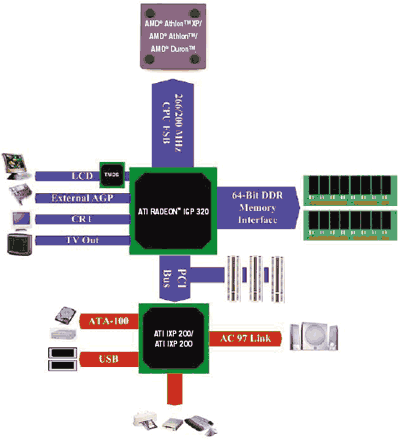
The Radeon IGP 320 will be used in Athlon systems
From a pure North Bridge perspective, ATI's Radeon IGP is nothing special. ATI does have licenses for both the Athlon's bus and the Pentium 4's bus so you will see one or the other supported in various Radeon IGPs (we'll get into the various model numbers later). The Radeon IGP features a single channel 64-bit DDR memory controller supporting either DDR200 or DDR266 SDRAM. While there is thought about supporting DDR333 that will be decided upon in the future but for now those two frequencies are it.
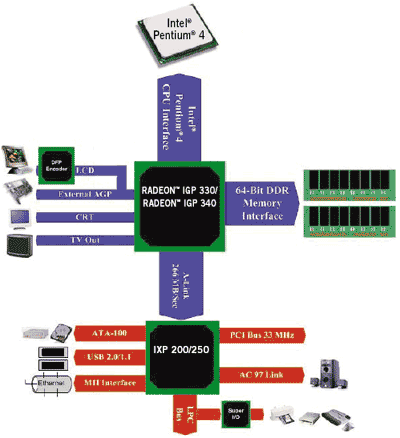
The Radeon IGP 330/340 will be used in Pentium 4 systems as well
The Radeon IGP has a 32-bit/33MHz point-to-point link that ATI calls their A-Link to connect to ATI's own South Bridge. This link is also designed in such a way that it is backwards compatible with 32-bit/33MHz PCI links meaning that the Radeon IGP can be used with a number of currently available South Bridges such as the VIA 686B.
Finally the Radeon IGP also features a connection to an AGP 4X port, rounding it out as your run-of-the-mill North Bridge.
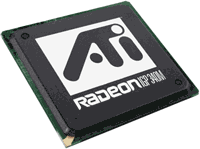 The
biggest selling point of the Radeon IGP however is its integrated graphics which
ATI promises will be leaps and bounds better than anything out there currently
(with the exception of the nForce). The integrated graphics is based on the
Radeon VE core which means that it has no Hardware T&L support, only a single
rendering pipeline, and the ability to output three texels per clock. On the
up-side this also means that the integrated graphics features HydraVision, ATI's
excellent hardware accelerated DVD playback (with iDCT and hardware motion compensation
support), and HyperZ. ATI's PowerPlay power saving technology is also included
in the Radeon IGP which makes a lot of sense for the mobile application of the
chipset (more on that later as well). The current IGP also lacks any integrated
TMDS transmitter which makes sense for the target market of the Radeon IGP.
The
biggest selling point of the Radeon IGP however is its integrated graphics which
ATI promises will be leaps and bounds better than anything out there currently
(with the exception of the nForce). The integrated graphics is based on the
Radeon VE core which means that it has no Hardware T&L support, only a single
rendering pipeline, and the ability to output three texels per clock. On the
up-side this also means that the integrated graphics features HydraVision, ATI's
excellent hardware accelerated DVD playback (with iDCT and hardware motion compensation
support), and HyperZ. ATI's PowerPlay power saving technology is also included
in the Radeon IGP which makes a lot of sense for the mobile application of the
chipset (more on that later as well). The current IGP also lacks any integrated
TMDS transmitter which makes sense for the target market of the Radeon IGP.
The integrated graphics core will eventually get a performance/feature bump as ATI does realize that the Radeon VE core isn't the most attractive, even if you're not too concerned with performance. By the end of this year or maybe into early 2003 ATI hopes to have a version of the Radeon IGP with a Radeon 8500 derived graphics core and in late 2003/early 2004 ATI expects to have their next-generation core integrated into their IGP product. This should give you an idea of what to expect from ATI on the chipset side of things, basically a single release every year.
By using a very small integrated graphics core and sticking to only a 64-bit DDR memory controller ATI is able to price the Radeon IGP competitively with solutions from ALi, SiS and VIA. This also means that the performance of the overall solution will definitely suffer as a result of a limited amount of memory bandwidth, remember that the 2.1GB/s provided by a 64-bit DDR266 bus must now be shared between the CPU and the integrated graphics core.
The X Stands for Communications
We mentioned earlier that ATI's Radeon IGP can interface either via a 32-bit PCI bus to a 3rd party South Bridge or ATI's A-Link bus to their own South Bridge. When using a 3rd party South Bridge you must keep in mind that none of the latest South Bridges (e.g. SiS 961, VIA VT8233A) can be used since they rely on proprietary links to connect to their northern counterparts. Instead, motherboard manufacturers will have to use an older South Bridge (e.g. VIA 686B) that uses the PCI bus to connect to the North Bridge. This makes opting for ATI's own South Bridge much more appetizing for motherboard manufacturers since these older 3rd party South Bridges obviously won't have the newest features.
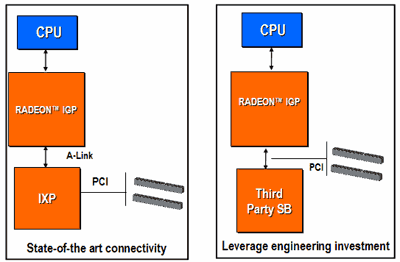
ATI calls their South Bridges their Integrated Communications Processor, or IXP for short (there are actually two Xs in communications, can you find them?). What you won't find in ATI's IXP is a high-powered DSP capable of Dolby Digital Encoding, instead you'll find a fairly conventional South Bridge with integrated LAN and USB 2.0.
The primary features of ATI's IXP are its integrated 3Com 10/100 Ethernet controller and a 6 port USB 2.0 controller. ATI's IXP does not support Ultra ATA 133 mainly because of a lack of OEM support for the standard.
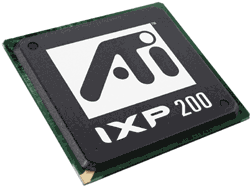 There
are two versions of ATI's IXP at this point, the IXP 200 and the IXP 250. Both
have the same basic feature set and use the same integrated 3Com Ethernet controllers
and USB 2.0 controllers. The difference between the two comes in their targeted
markets; the IXP 200 is aimed at the home user while the IXP 250 is aimed at
the business user. The IXP 250 thus features support for remote wake on LAN,
desktop management interface, ASF, etc… These are all features that aren't
really necessary for the home user and thus the IXP 200 will suit most users
just fine.
There
are two versions of ATI's IXP at this point, the IXP 200 and the IXP 250. Both
have the same basic feature set and use the same integrated 3Com Ethernet controllers
and USB 2.0 controllers. The difference between the two comes in their targeted
markets; the IXP 200 is aimed at the home user while the IXP 250 is aimed at
the business user. The IXP 250 thus features support for remote wake on LAN,
desktop management interface, ASF, etc… These are all features that aren't
really necessary for the home user and thus the IXP 200 will suit most users
just fine.
Again without any expensive DSP licenses, ATI's IXP should be priced competitively with ALi, SiS and VIA South Bridges. Although the first Radeon IGP chipsets will appear before then, the first IXP chips will be available in July of this year. Until then, motherboard manufacturers will have to rely on 3rd party South Bridges.
One Driver for All
Much like NVIDIA's unified driver architecture model, ATI has coined the term FlexFIT for their Radeon IGP unified driver model. Without actually looking at the Radeon IGP drivers we can't make a comparison between ATI's model and NVIDIA's but as far as we can tell they are relatively similar at least conceptually. A single installation package will be used for all of the integrated features of the chipset.
The Biggest Win - Notebooks
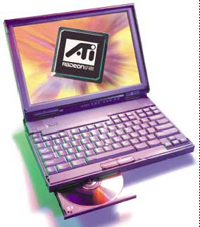 If
you've been reading carefully up to this point you'll realize that the Radeon
IGP doesn't sound like anything more than a conventional PC chipset except with
improved integrated graphics; and in fact, that's a very good way of summing
it up. But there is one key point that we've left out until this point, the
Radeon IGP is designed for operation in desktop and mobile systems. One of the
biggest wishes virtually everyone mentioned in their articles on NVIDIA's nForce
was the hope that the technology would make it to the mobile world. NVIDIA has
always taken the stance that it's a logical progression for nForce to go mobile
but there isn't enough power saving logic in the chipset as it stands today
to make that possible; with the Radeon IGP however, it is quite possible.
If
you've been reading carefully up to this point you'll realize that the Radeon
IGP doesn't sound like anything more than a conventional PC chipset except with
improved integrated graphics; and in fact, that's a very good way of summing
it up. But there is one key point that we've left out until this point, the
Radeon IGP is designed for operation in desktop and mobile systems. One of the
biggest wishes virtually everyone mentioned in their articles on NVIDIA's nForce
was the hope that the technology would make it to the mobile world. NVIDIA has
always taken the stance that it's a logical progression for nForce to go mobile
but there isn't enough power saving logic in the chipset as it stands today
to make that possible; with the Radeon IGP however, it is quite possible.
To make things even more interesting, ATI can build Radeon IGP chipsets for both the Athlon XP and the Pentium 4 as they're fully licensed for the two platforms. This is something that even NVIDIA cannot claim. It also means that ATI will be almost a lone ranger in the mobile Pentium 4 market.
The first time we ever saw the Radeon IGP was in a notebook demonstration at Fall Comdex 2001 (yet another very interesting thing that we couldn't let you all know about) and more recently during IDF we were able to take a look at a few more notebooks running the chipset. The chipset is running Windows XP just fine and there didn't seem to be any major issues during the demo, hopefully indicating that ATI is on track with their release schedule.
Welcome to the Family
Exactly what will ATI be releasing and when? As it stands now, the Radeon IGP consists of five different IGP parts and two IXPs. We already mentioned the two IXPs (200 and 250) as well as their differences, also remember that these two IXPs can be used interchangeably with any of the IGPs.
On the Athlon side of things we have the Radeon IGP 320 and 320M. These chips will support both a 100MHz and 133MHz (200/266MHz DDR) FSB and they only differ in that the 320M will be used for mobile Athlon 4 procesors.
For the Pentium 4 ATI has a few more chipsets they'll be offering. The Radeon IGP 330 will only be offered in a desktop version and will be ATI's first Pentium 4 solution with support for the 400MHz FSB. Then, ATI will release the Radeon IGP 340 and 340M with support for the 533MHz FSB (while the 330 will be kept around for the next-generation 400MHz FSB Celerons). Again the 'M' denotes mobile thus making the 340M a mobile Pentium 4 chipset.
The integrated graphics and all of the other features should remain the same across this entire family, the only exception being the Radeon IGP 340. Because it'll be the last IGP out the gates the Radeon IGP 340 is currently planned to have a higher graphics clock speed than the 330 and 320.
As far as a release schedule, here's what ATI's tentative plans are:
|
Platform
|
Estimated
Release
|
|
| Radeon IGP 320 |
Athlon
|
May
'02
|
| Radeon IGP 320M |
Mobile
Athlon
|
May
'02
|
| Radeon IGP 330 |
Pentium
4 / next-gen Celeron
|
Summer
'02
|
| Radeon IGP 340 |
Pentium
4
|
Summer
'02
|
| Radeon IGP 340M |
Mobile
Pentium 4
|
Summer
'02
|
| IXP 200 |
All
|
Summer
'02
|
| IXP 250 |
All
|
Summer
'02
|
Final Words
While clearly not as hard hitting and impressive as NVIDIA's initial nForce launch at Computex, we do believe that ATI is on the right track with their Radeon IGP line of chipsets. From a high level overview such as what we have given you today it's clear to see that ATI is taking a very conventional approach to their entry into the chipset business. This makes a lot of sense since it's this very same approach that Intel and VIA have used for years and it seems to be working just fine.
But there's much more to be done than put together a set of solid looking specifications as NVIDIA has definitely learned from the nForce. There is much more validation that must go into a chipset platform than a graphics card and support from motherboard manufacturers is definitely key. As it stands the only notebook partners publicly announcing support for the Radeon IGP are Arima, Compal and Quanta. On the desktop side, ATI is announcing with familiar faces like FIC and Gigabyte.
While the potential of having another solid chipset competitor in the desktop market is definitely a good thing, we're actually much more interested in seeing the Radeon IGP used in notebooks - preferably this year on when Radeon 8500 based graphics core moves into the chipset. ATI's great relationships with the major OEMs should help out tremendously in achieving that but as we know all too well, things move much slower in the notebook market than we're used to so it may take a while.
ATI will have a long road ahead if they want to take a bigger chunk out of the market than NVIDIA did. What you should remember however is that ATI's direct competition in the chipset market isn't NVIDIA, it's VIA. It will be interesting to see not only how ATI fares in competition with the Taiwanese giant but also if it drives VIA to do anything special with their current line of integrated chipsets.
This marks the second major initiative by a graphics manufacturer to enter the PC chipset business, we can only hope that it'll be more successful than the first - good luck.







